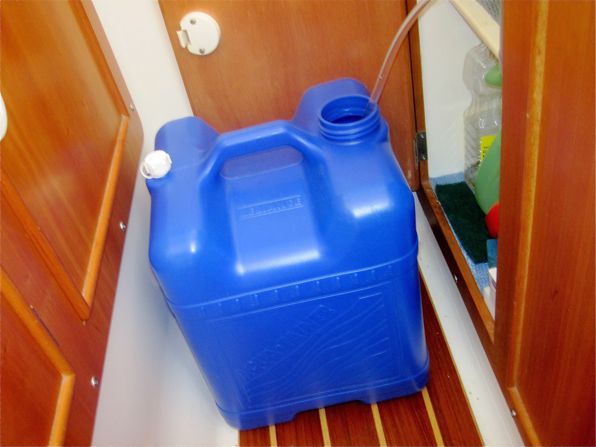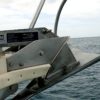Katadyn 80E watermaker observations
I had a request to write a post relating to our experience with the watermaker that we installed prior to heading out cruising. Back in March, 2010, we bit the bullet and placed an order for a Katadyn Powersurvivor 80E desalinator (aka watermaker). The device arrived some 6 weeks later and I had it pretty much installed within a week, tweaking the install a bit a week after that. Even though we had the unit installed while we were back in Canada, we waited until we were in the relatively clean and clear water of the Bahamas before we started using it, partly to protect the membrane and also because we had little need for it given the ease of acquiring fresh water while in the US. Each of the links above show the installation steps and how we use the watermaker so rather than rewriting it all, if you’re curious about that stuff, please check those older posts.

Now that we have been using the watermaker for almost 6 months, here are our observations:
- We opted to do a very K.I.S.S. install. Upon first starting up the unit, we direct the product water output hose into our galley sink and let it run for 5 minutes. We used to just let this water run down the drain but now we keep the stopper in the sink and use that not-quite-good-enough-for-drinking water to wash the dirty dishes.
- After 5 minutes has gone by, we test the water with the TSD (total dissolved solids) meter that came with the unit and assuming that it is OK (it always is), we put the output hose into one of several water jerry cans that we keep on board.
- We run a timer while the WM is running and periodically check the jerry can so that it doesn’t overflow. When the jerry can is full or we are ready to turn the unit off, we again test the water coming out of the output hose. If it again tests OK, we then know that the water in the jerry can is safe to drink and we can empty it into our main water supply tank.
- We have come across a couple of people who have their watermaker output directly fed into their one and only water tank. THIS IS VERY BAD. If, for whatever reason, the watermaker fails while in operation, the entire water supply could be contaminated. Imagine this happening while on a Pacific crossing. Not good. If we were to take the next step and have it plumbed into a permanent tank, we would install a second one to keep the output separate from the main supply until it is verified to be completely safe.
- The Katadyn 80E specs say that it will produce 3-4 gallons per hour. We find this to be about right. It also says that it will draw 8 amps while running and we also find this to be accurate. Because of this relatively large power draw, we like to run it either when the sun is shining brightly on our solar panels, our engines are running or we have our Honda generator going. The pump is also quite sensitive to low battery voltage (you’ll hear it go “clunk, clunk” while running if the voltage is down) which is another reason to run it only in the above situations.
- The Katadyn representative that we met in Georgetown suggested that we run the unit EVERY DAY, even if only for 5 minutes. We try to do this. We definitely run it every 3 days at the maximum.
- We are pretty careful about when we run the unit, making sure that the input water is relatively clean. Harbors are not so good as any petroleum products in the water can kill the membrane ($$$). Cloudy/dirty water is also not good as it will clog the filters. The best time would be while sailing offshore. The difficult part of this is that we can’t really run it when we’re offshore in rough seas because the input, while underwater, is near the bow. In big waves our bows leave the water intermittently, making it difficult for the WM to get consistent input. We watch the output if we have any concerns in situations like this.
- Would we like a higher output watermaker? Yes, I guess so. Would we want to spend the money on one? No. I think we’re pretty comfortable that this unit fills our needs. Would we want a “fancier” unit with more bells and whistles? No, definitely not. We chose this model because of the simple design and are happy that we did. It seems pretty bullet proof to me. We do carry several spare pre-filters (we’ve changed it once) and we also have spare seal kit, just in case.

Output hose fed into a jerry can.

Checking the water output. The figure shown, 845, is not safe for drinking.
We usually see 200-250 on the meter.



Great post Mike! I wonder how your collection method would work on a monohull? I think keeping the output seperate until tested makes perfect sense but wonder if its practical to try to collect it on moving and bouncing mono. I guess that’s another reason to put in a single bowl sink in the galley- a sturdy place to put the jerry can while underway but you do lose the option of using the almost good water for washing up.
I would assume that there are plenty of people on monos who do something similar. I think you’d quickly figure out some way to secure the jerry can for your boat. Inside the sink is a nice idea though.
Very nice. A good summary. I am amazed at how you can come up with something relevant, day after day.
Regarding TDS, while 250 is a good number, it can be considerably higher and still be “safe.”
The EPA secondary standard is 500 ppm and is based upon asthetics (taste) and not safety.
http://water.epa.gov/drink/contaminants/secondarystandards.cfm
The World Health ORganization (WHO) set their standard generally at 1000 ppm.
http://whqlibdoc.who.int/monograph/WHO_MONO_49_(chp9-13).pdf
In fact, TDS numbers of 800-1200 ppm are not uncommon in well water in many areas of the US desert south west. The entire area–and the reason there is oil there–is underlain by old dried up oceans, and oil wells commonly turn up water 10 times as salty as the ocean. One of my projects involves recycling this water.
So, while cleaner is better and I would not change your practices, in a bind I would not be put off by numbers as high as 1,000 ppm or even more (seawater is ~ 35,000 ppm). Just so you know.
Hi Drew. I am amazed too:)
Thanks for the info on the TDS readings. That is good to know!
How difficult ($$$) would it be to install and secondary water tank that could fill up your primary tank?
Not likely that expensive. You (we) would need to find a suitable place for the tank and plumb it in. We’d also need to give some thought to how we want the system to work as there are several options.
Good timing….Thanks
🙂
hi gents, thks for yr nice site,
i could not find this link :
“Here is a nice watermaker FAQ I found while searching the net.”
still have it ?
thks
Sorry, Bruno, I guess not. I removed that text.